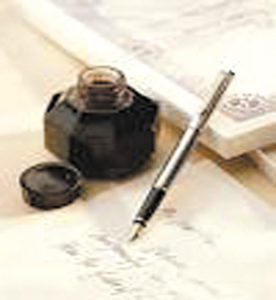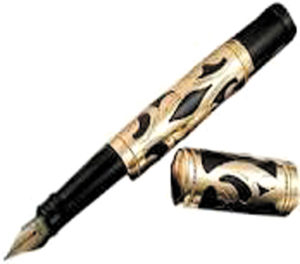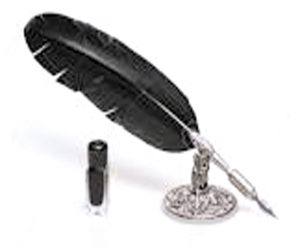 By Henry J. Pratt
By Henry J. Pratt Decades ago from a fountain of black ink, famed British author Rudyard Kipling penned his popular Barrack Room Ballads and The Jungle Book. When he was a newspaper reporter, Kipling took notes in pencil, but later he wrote his exciting fiction with nothing but an old ink pen.
Today, both old and new quality quills are enjoying a resurgence of popularity across the United States. Wardrobe and jewelry fanciers are buying the new, expensive pens in increased quantities, creating more than just a fountain of wealth for a relatively few pen manufacturers. More and more antiques collectors and word-smiths are latching on to stately old pens of the past.
Some pens, like jewelry, are considered works of art. The Museum of Modern Art in New York has several pens of varying varieties in its permanent collection. Many pen connoisseurs wear beautiful pens instead of jewelry with fine suits and gowns.
Frequently, fountain pens are made of gold, silver, brass, stainless steel or Chinese lacquer. A West German manufacturer, Mont Blanc, makes an 18-karat gold pen retailing for $6,500. President Reagan often used a less expensive Mont Blanc, which sells for $250, when he signs Oval Office documents.
History buffs, wordsmiths with a nostalgic bent, and antiques collectors everywhere are contributing to the resurging interest in writing instruments of our past. “The pen is the tongue of the mind,” Cervantes aptly wrote in Don Quixote.
Likewise, it was a wise Lord Lytton in Richlieu who wrote the oft-quoted “the pen is mightier than the sword.” Indeed, the writing instruments man used to spin stories about himself down through history are a fascinating scenario in themselves.
Historians say that, while man started graphically recording images and signs thousands of years ago, our present-day pen’s ancestors didn’t appear until suitable writing surfaces become available.
Early man marked his cave walls and baked clay tablets with stone chisels and styluses. Later, the Chinese painted and wrote with a coarse brush, though it was ill-adapted to write history with the delicacy of pen and ink. In about 1500 B.C., the Egyptians discovered how to make a papyrus reed pen from bamboo plants that would accept fine lines of colored liquids.
 Quills were used for writing as early as 600 A.D., and from then until about 1830, quill pens proved popular. History buffs say President Thomas Jefferson raised geese to supply his desk with writing quills. But some researchers suspect Jefferson also liked roast goose on his dinner table.
Quills were used for writing as early as 600 A.D., and from then until about 1830, quill pens proved popular. History buffs say President Thomas Jefferson raised geese to supply his desk with writing quills. But some researchers suspect Jefferson also liked roast goose on his dinner table. As early as 1748, French craftsmen produced hand-made steel pens. It was not until 1859, however, that the first steel pen company was established in the U.S. Richard Esterbrook Jr. took the honors with a plant built in Camden, New Jersey. Eventually, Esterbrook became the largest pen manufacturer in the world.
One day in 1884, a New York insurance salesman, Lewis E. Waterman, became frustrated and angry over losing a hefty commission when his leaky, old-fashioned dip pen flooded an important policy document. A short time later, Waterman discovered that a narrow opening in the pen point would allow ink to flow smoothly from barrel to tip through capillary action.
Thus, it was Waterman who created a writing instrument that was both superior and reliable, and more portable, than any used before.
Pen promotional displays of the day advised parents to “send her to school with a Waterman.” One hundred years later, Waterman’s fountain pen officially entered the ranks of the antique.
Though Waterman’s first fountain pen was acceptable enough to be manufactured in quantity, it was a reservoir pen that had to be filled with an eyedropper. The automatic or lever-filled pen was not available until 1913.
The fountain pen proved to be indispensable for most Americans. For many others, it became a prized personal possession to show off, a major showcase artifact, or a cocktail party conversation piece. Fountain pens became very popular. Statistics show only 1.5 million pens were made in 1905, but by 1929, nearly 20 million pens—worth $34 million—were sold.
High-priced limited editions of fountain pens were made, including Tiffany creations. You could buy pens with jade barrels or have them encrusted with gold and silver jewels. The sky almost was the limit.
America’s traveling salesmen bought and wrote orders with the dressiest, most unusual fountain pens. Some pens looked like umbrellas. One pen had a peephole with the Lord’s prayer concealed inside.
 In yesteryear, a “cigarette” pen had a cork tip; another was made of gold with a cigarette lighter on one end. One pen had a stapler on one end, and another was shaped like a matchstick.
In yesteryear, a “cigarette” pen had a cork tip; another was made of gold with a cigarette lighter on one end. One pen had a stapler on one end, and another was shaped like a matchstick. One of the growing numbers of collectors of old fountain pens is Goldie V. Claffey of Phoenix, Arizona. She told Arizona Antique Society members that in a 1908 Sears catalog one could order a gold and pearl pen for $1.10. For 25 cents more, Sears would put the pen in a satin-lined box. Add another three cents and your new fountain pen would be registered in your name and mailed promptly to your home.
One cannot cover history’s writing instruments without describing the development of ball-point pens. They were first covered in a U.S. patent issued to J.J. Loud in 1888. His patent introduced a revolutionary replacement of a pen’s traditional “nib” with a minute rolling ball, one facing bathed in an ink reservoir. The opposite face somewhat magically and smoothly transferred the ink to paper.
It was not until 1937, though, that the modern workable form of the ball-point pen was invented by Laszlo J. Biro, a Hungarian citizen living in Argentina. By 1944, the ball-point pen had gained worldwide popularity.
The U.S. Army’s World War II Quartermaster General spurred American acceptance of the ball-point pen. For soldiers’ use, he requested a writing instrument that wouldn’t leak at high altitudes, would use a quick-drying ink for long time periods, and would be un-affected by climate changes.
In 1947 Congress passed a law that prohibited check writing with a ball-point pen because signatures could be easily transferred and forged by the thumb. The law itself went antique and such technical problems have long since vanished. Today, the ball-point pen industry sells more than 2 billion units of refillable or disposable pens each year in the U.S. alone.
Most fountain pen collectors consider the fabled “Snake Pen,” produced by Parker in the early 1900s, as the crown jewel of old pens. Originally costing $10-$12 (more than three weeks’ salary then for most people), the “Snake Pen” featured a gold-encased barrel and cap entwined exquisitely with a jewel-eyed snake. Pen experts say such a writing instrument changes hands today for no less than $12,000.
Serious old pen hobbyists may be interested in a monthly publication covering pen history, copies of old pen ads, and pen repair information. One such issueance is: The Pen Fancier’s Magazine, 1169 Overcash Dr., Dunedin, Florida 33528.
An elegant fountain pen of today or yesteryear won’t make you a Rudyard Kipling or a Willa Cather overnight. You may not get rich quickly either by trading for one. But such a pen, indeed, can highlight your wardrobe or sparkle up your den’s trophy case.
Truly, a quality quill or a display of several pens in your home can perk up party conversations and give you and your family hours of nostalgic pleasure. You’ll find never-ending joy in learning more about the writing tools man used down through the centuries to pen stories about himself.















Follow Us